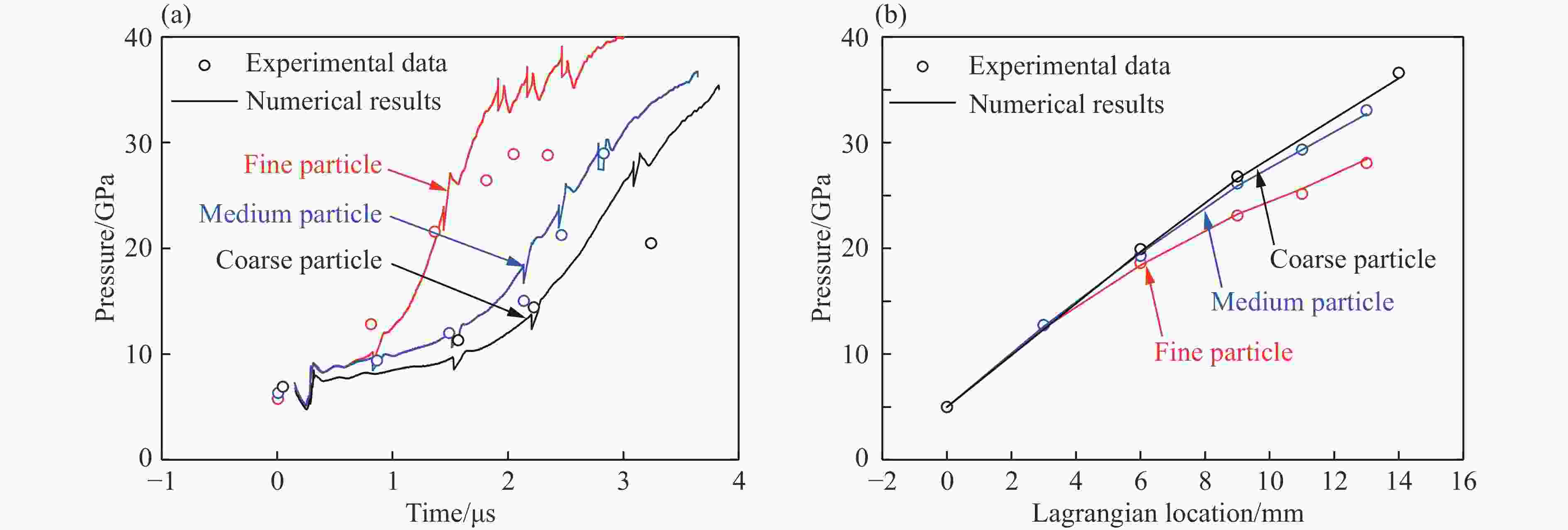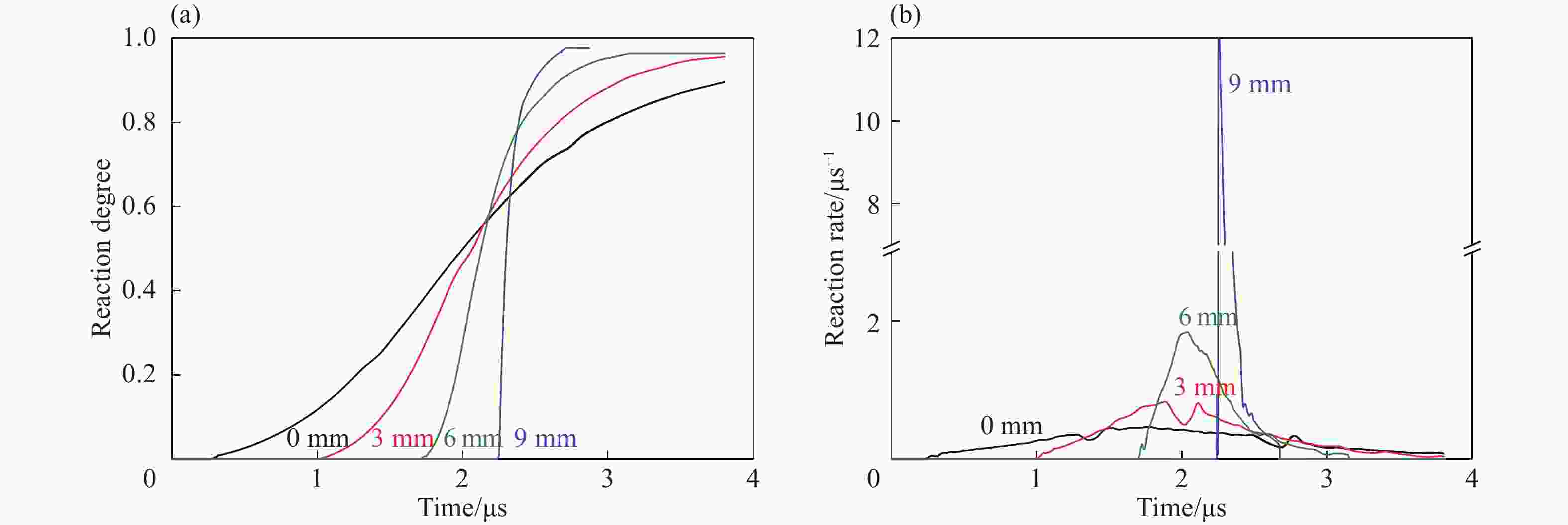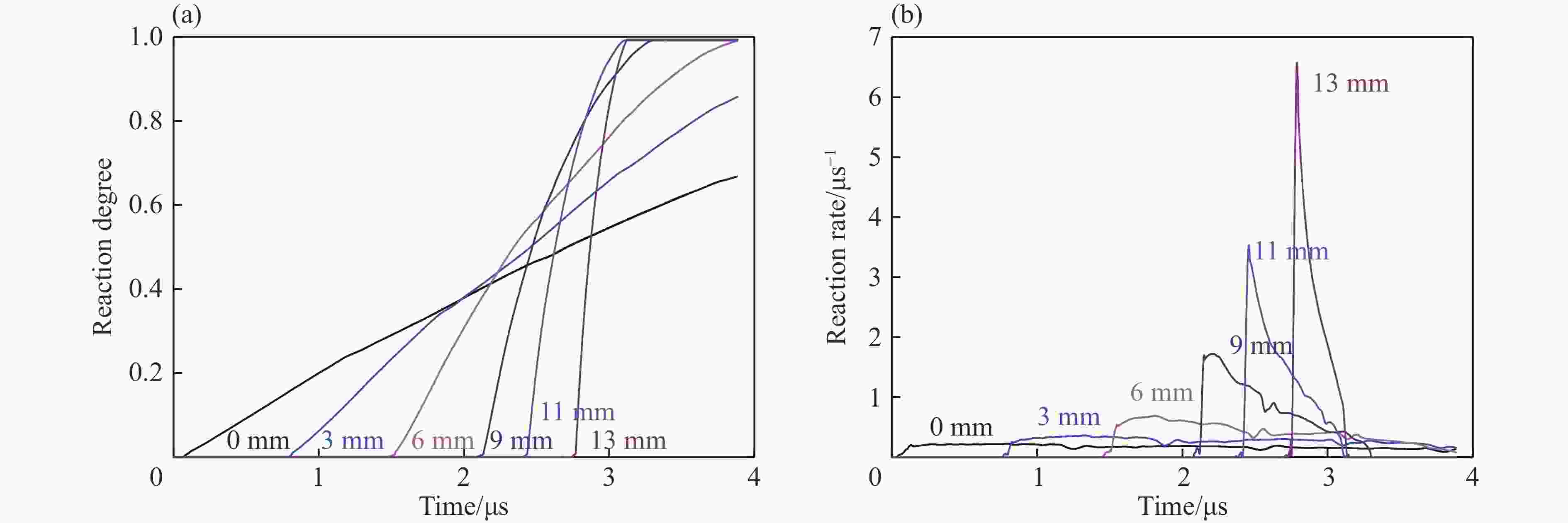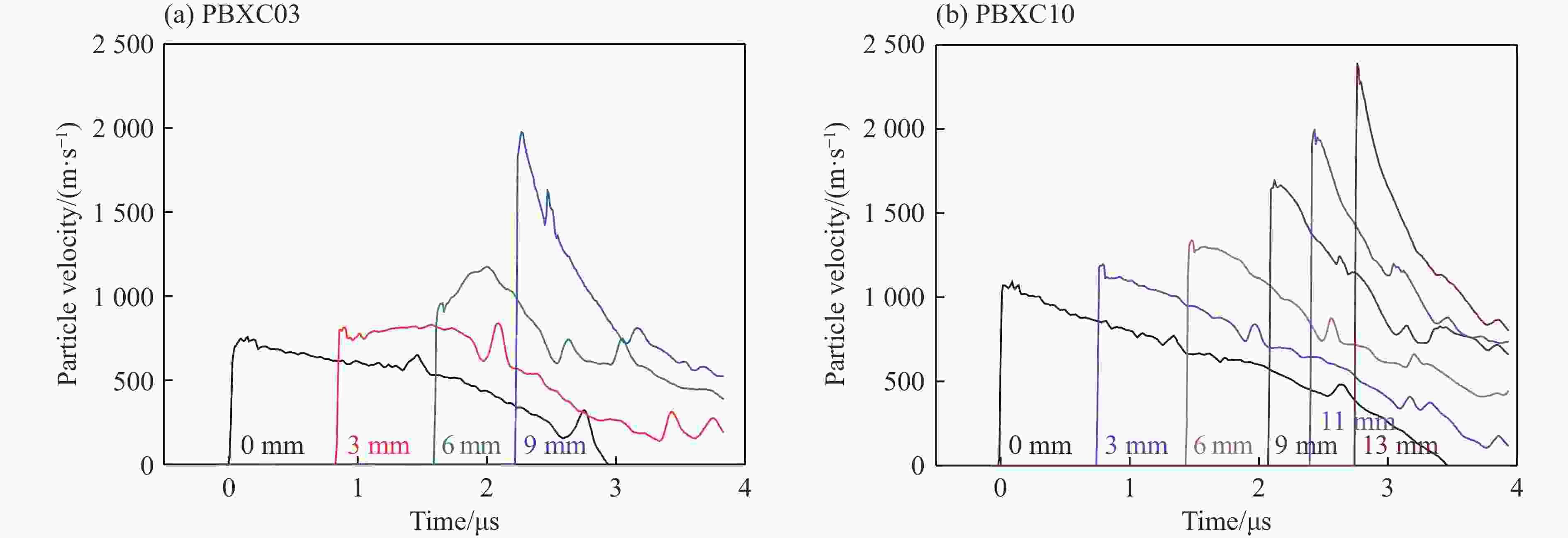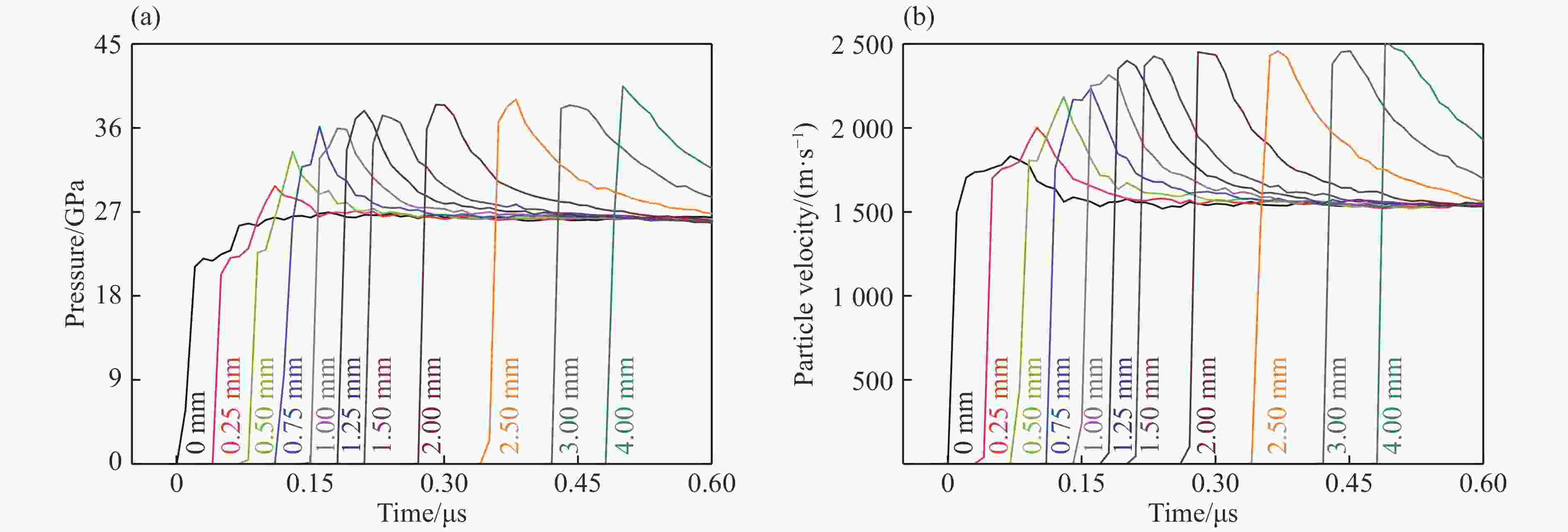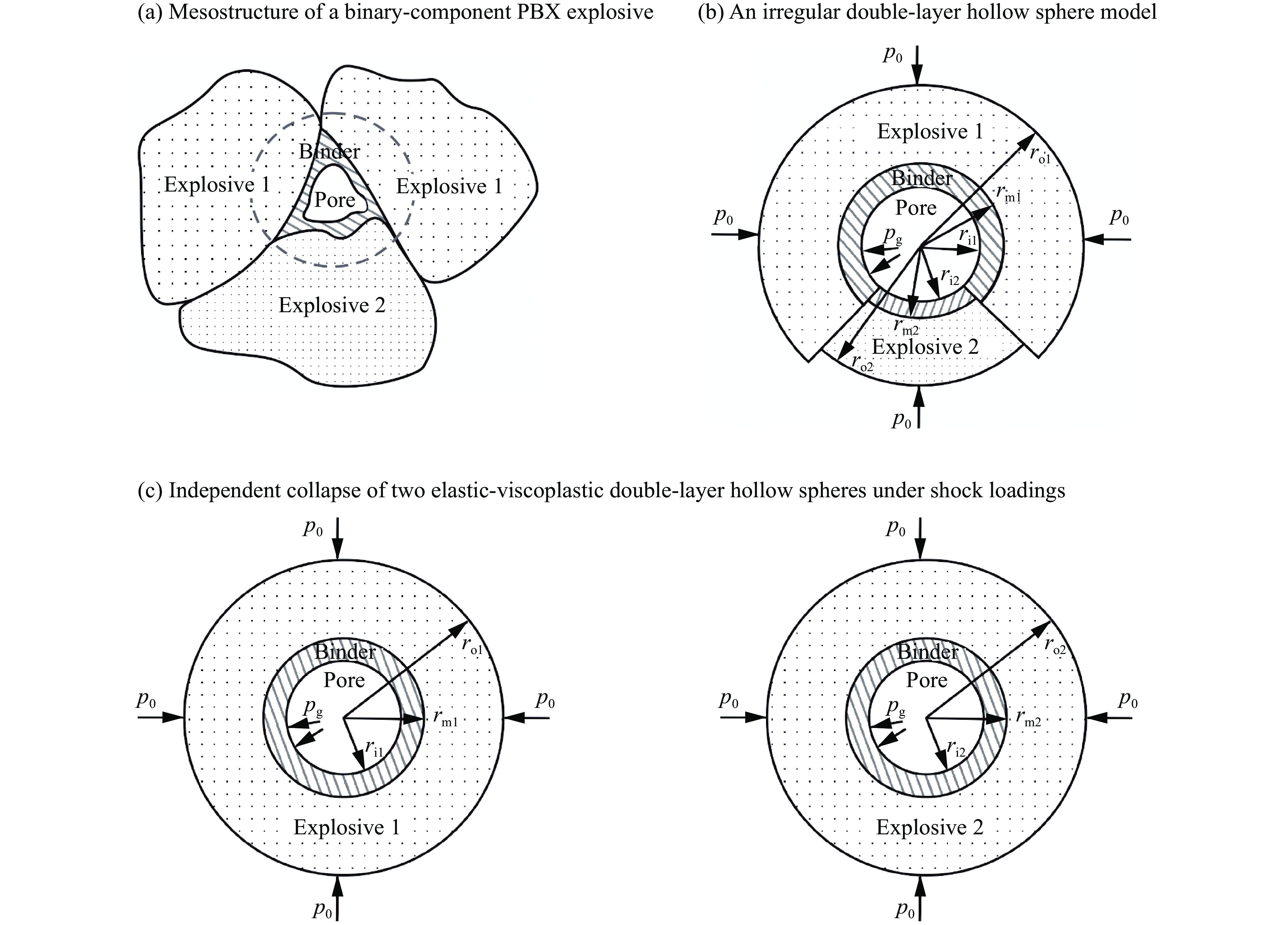A multi-component Duan-Zhang-Kim mesoscopic reaction rate model for shock initiation of multi-component PBX explosives
-
摘要: 提出了多元混合PBX炸药孔隙塌缩热点模型新的处理方法,构建了新的细观反应速率模型,系列数值模拟结果与实验结果均一致,表明该细观反应速率模型可较好地描述和预测炸药组分配比及颗粒度对多元混合PBX炸药冲击起爆过程的影响。PBX炸药冲击起爆过程主要受热点点火过程和燃烧反应过程共同作用:HMX占主导成分的PBXC03炸药,起爆压力低,冲击起爆过程受热点点火影响较明显,热点点火后的燃烧反应速度较快,表现为加速反应特性;TATB占主导成分的钝感PBXC10炸药,起爆压力高,冲击起爆过程主要受点火后的燃烧反应过程控制,且点火后燃烧反应速度较慢,表现为稳定反应特性。Abstract: This paper offers a new method for calculating the reaction rate of the pore collapse hot-spot ignition in multi-component PBX explosives, and proposes a new mesoscopic reaction rate model capable of describing and predicting the shock initiation and detonation behavior of multi-component PBX explosives with any explosive components proportion as well as any explosive particle size. The pressure-time histories in the explosive samples calculated using this mesoscopic reaction rate model are in good agreement with the experimental data. The shock initiation and detonation process of PBX explosives is mainly controlled by both the hot-spot ignition processes and the combustion reaction processes. The PBXC03 explosive with the dominant component of HMX is mainly controlled by the hot-spot ignition and shows the accelerated reaction characteristics. With the dominant component of insensitive TATB, the critical initiation pressure of PBXC10 is high and the shock initiation behavior is controlled by the combustion reaction process, which shows a stable reaction characteristics.
-
表 1 常温下PBXC03和PBXC10炸药中HMX和TATB的热点点火项参数[19]
Table 1. Thermodynamic parameters of hot-spot ignition terms for HMX and TATB[19]
炸药组分l=1,2 Zl/μs−1 Tl*/K T0l/K γel/μs−1 cpl/(cm2·μs−2·K−1) kel/MPa Ql/(g·μs−2·cm−1) HMX 5.0×1013 26 500 298 0.026 1.4×10−5 8 5.439×10−2 TATB 3.18×1019 30 140.8 298 0.026 2.005×10−5 8 2.510×10−2 表 2 PBX9501和LX-17炸药的反应速率模型第二、三项系数
Table 2. Parameters of the second and the third terms in Eq.(5) for PBX9501 and LX-17
炸药组分(l=1,2) al bl nl Gl ml sl PBX9501(HMX基) 0.027 2.05 1.00 800.0 3.355 1.00 LX-17(TATB基) 0.01 1.70 2.03 220.0 3.077 0.2 表 3 PBXC03和PBXC10炸药中各取代基体的体积分数
Table 3. Volume fractions of each substituted explosive component in PBXC10 and PBXC03
体积分数 PBX9501(HMX基) PBXC03 PBXC10 LX-17(TATB基) χ1 1 0.923 193 0.247 764 0 χ2 0 0.076 807 0.752 236 1 表 4 PBXC03和PBXC10炸药组分配比及物理参数[19]
Table 4. Components proportions and physical parameters of PBXC03 and PBXC10[19]
炸药名称 组分及配比 装药密度
ρ/(g·cm−3)理论密度
ρt /(g·cm−3)平均颗粒度/μm HMX/TATB/黏结剂 重量/% 体积/% HMX TATB PBXC03 87/7/6 85.58/6.76/7.66 1.849 1.873 20~30 (细颗粒) 70~90 (中等颗粒) 100~130 (粗颗粒) 15 PBXC10 25/70/5 25.4/69.8/4.8 1.900 1.934 表 5 PBXC03和PBXC10炸药爆轰产物和未反应炸药状态方程参数[19]
Table 5. JWL EOS parameters for detonation products and unreacted PBXC03 and PBXC10[19]
参数 PBXC03 PBXC10 爆轰产物 未反应炸药 爆轰产物 未反应炸药 A/GPa 1 025.45 27 213 759.0 612.8 12 734.089 B/GPa 22.57 −73.854 4 18.58 −8.982 0 R1 4.91 19.87 4.32 10.4 R2 1.37 1.987 1.79 1.04 ω 0.29 1.99 0.21 2.50 cV/(GPa·K−1) 1.0×10−3 1.693 2×10−2 1.0×10−3 3.731 22×10−2 E0/GPa 10.0 — 10.0 — -
[1] BOLTON O, SIMKE L R, PAGORIA P F, et al. High power explosive with good sensitivity: a 2:1 cocrystal of CL-20: HMX [J]. Crystal Growth and Design, 2012, 12(9): 4311–4314. DOI: 10.1021/cg3010882. [2] TARVER C M, TRAN T D. Thermal decomposition models for HMX-based plastic bonded explosives [J]. Combustion and Flame, 2004, 137(1/2): 50–62. DOI: 10.1016/j.combustflame.2004.01.002. [3] URTIEW P A, FORBES J W, GARCIA F, et al. Shock Initiation of UF-TATB at 250 ℃ [C] // FURNISH M D, HORIE Y, THADHANI N N. Shock Compression of Condensed Matter-2001. United States: American Institute of Physics, 2002: 1039−1042. DOI: 10.1063/1.1483716. [4] AN Chongwei, LI Hequn, YE Baoyun, et al. Preparation and characterization of ultrafine HMX/TATB explosive co-crystals [J]. Central European Journal of Energetic Materials, 2017, 14(4): 876–887. DOI: 10.22211/cejem/77125. [5] WANG Z, GUO X, WU F, et al. Preparation of HMX/TATB composite particles using a mechanochemical approach [J]. Propellants, Explosives, Pyrotechnics, 2016, 41(2): 327–333. DOI: 10.1002/prep.201500136. [6] GREBENKIN K F. Comparative analysis of physical mechanisms of detonation initiation in HMX and in a low-sensitive explosive (TATB) [J]. Combustion, Explosion, and Shock Waves, 2009, 45(1): 78–87. DOI: 10.1007/s10573-009-0011-y. [7] AUSTIN R, BARTON N, HOWARD W, et al. Modeling pore collapse and chemical reactions in shock-loaded HMX crystals [J]. Journal of Physics: Conference Series, 2014, 500(5): 052002–052007. DOI: 10.1088/1742-6596/500/5/052002. [8] KAPAHI A. Dynamics of void collapse in shocked energetic materials: physics of void-void interactions [J]. Shock Waves, 2013, 23(6): 537–558. DOI: 10.1007/s00193-013-0439-6. [9] OZLEM M, SCHWENDEMAN D W, KAPILA A K, et al. A numerical study of shock-induced cavity collapse [J]. Shock Waves, 2012, 22(2): 89–117. DOI: 10.1007/s00193-011-0352-9. [10] TRAN L, UDAYKUMAR H S. Simulation of void collapse in an energetic material: Part 1: inert case [J]. Journal of Propulsion and Power, 2006, 22(5): 947–958. DOI: 10.2514/1.13146. [11] ZHOU Tingting, LOU Jianfeng, ZHANG Yangeng, et al. Hot spot formation and chemical reaction initiation in shocked HMX crystals with nanovoids: a large-scale reactive molecular dynamics study [J]. Physical Chemistry Chemical Physics, 2016, 18(26): 17627–17645. DOI: 10.1039/C6CP02015A. [12] MASSONI J, SAUREL R, BAUDIN G, et al. A mechanistic model for shock initiation of solid explosives [J]. Physics of Fluids, 1999, 11(3): 710–736. DOI: 10.1063/1.869941. [13] SOUERS P C, GARZA R, VITELLO P. Ignition & growth and JWL++ detonation models in coarse zones [J]. Propellants, Explosives, Pyrotechnics, 2002, 27(2): 62–71. DOI: 10.1002/1521-4087(200204)27:23.0.CO;2-5. [14] STARKENBERG J. Modeling detonation propagation and failure using explosive initiation models in a conventional hydrocode [C] // SHOR J M, MAIENSCHEIN J L. The 12th Symposium (International) on Detonation. USA: Office of Naval Research, 2002: 1001−1007. [15] SHAW M S, MENIKOFF R. A reactive burn model for shock initiation in a PBX: scaling and separability based on the hot spot concept [C] // PEIRIS C B S, ASAY B. The 14th Symposium (International) on Detonation. USA: Office of Naval Research, 2010. [16] DUAN Zhuoping, WEN Lijing, LIU Yan, et al. A pore collapse model for hot-spot ignition in shocked multi-component explosives [J]. International Journal of Nonlinear Sciences and Numerical Simulation, 2010, 11(S): 19–24. DOI: 10.1515/IJNSNS.2010.11.S1.19. [17] KIM K. Development of a model of reaction rates in shocked multicomponent explosives [C] // LEE E L, SHORT J M. The 9th Symposium (International) on Detonation. USA: Office of the Chief of Naval Researche, 1989: 593−603. [18] WEN Lijing, DUAN Zhuoping, ZHANG Liansheng, et al. Effects of HMX particle size on the shock initiation of PBXC03 explosive [J]. International Journal of Nonlinear Sciences and Numerical Simulation, 2012, 13(2): 189–194. DOI: 10.1515/ijnsns.2011.129. [19] 温丽晶. PBX炸药冲击起爆细观反应速率模型研究[D]. 北京: 北京理工大学, 2011.WEN Lijing. Research on mesoscopic reaction rate model of shock initiation of PBX [D]. Beijing: Beijing Institute of Technology, 2011. [20] LIU Y R, DUAN Z P, ZHANG Z Y, et al. A mesoscopic reaction rate model for shock initiation of multi-component PBX explosives [J]. Journal of Hazardous Materials, 2016, 317: 44–51. DOI: 10.1016/j.jhazmat.2016.05.052. [21] URTIEW P A, TARVER C M. Shock initiation of energetic materials at different initial temperatures: review [J]. Combustion, Explosion, and Shock Waves, 2005, 41(6): 766–776. DOI: 10.1007/s10573-005-0085-0. [22] URTIEW P A, VANDERSALL K S, TARVER C M, et al. Initiation of heated PBX-9501 explosive when exposed to dynamic loading: UCRL-CONF-214667 [R]. United States: Lawrence Livermore National Laboratory, 2005. -






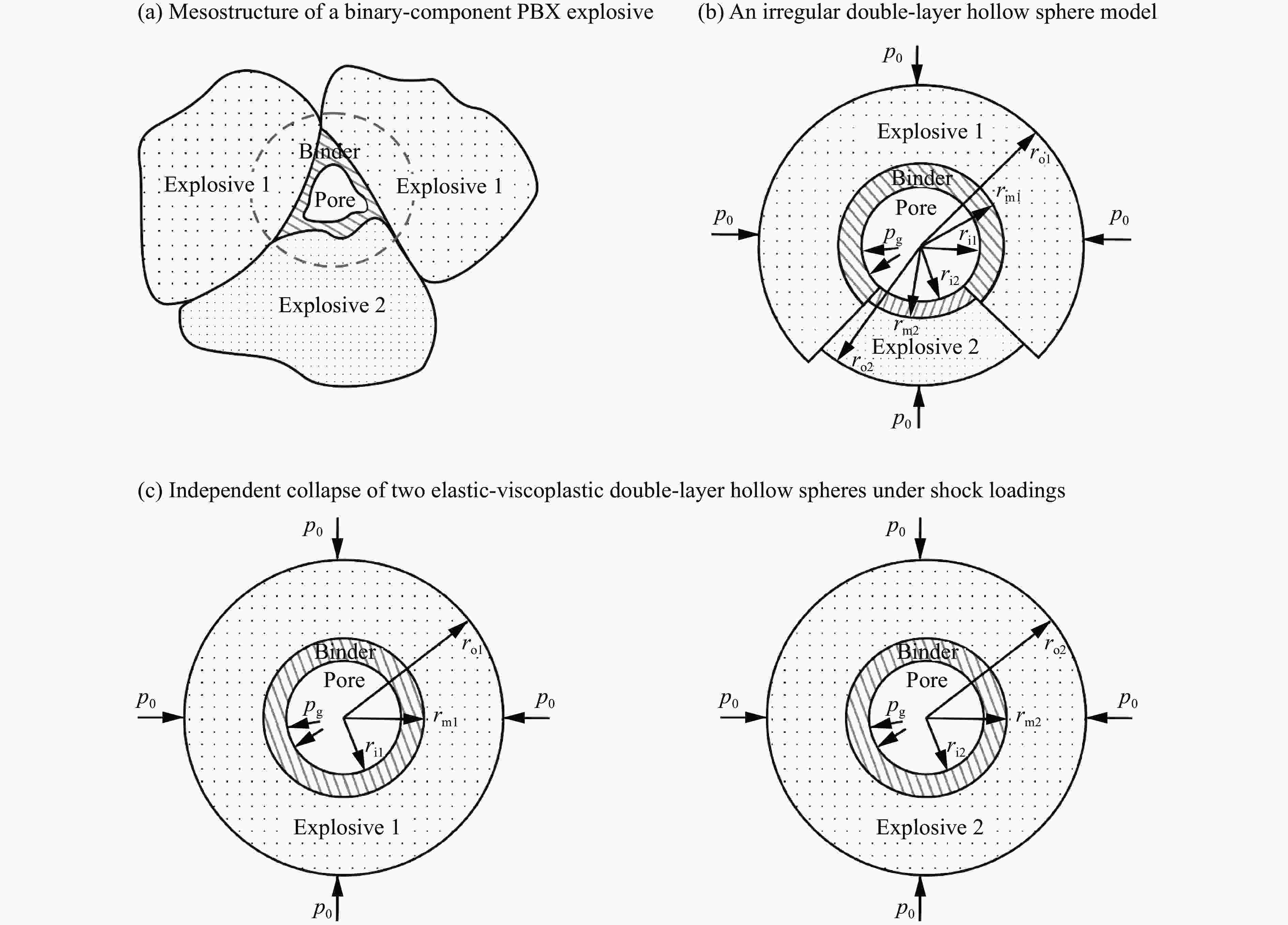
 下载:
下载:




